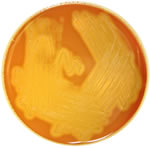Streptococcus dysgalactiae subspecies equisimilis
- Organism Specific Information
- Concatenate Sequences
- Download Alleles
- Download ST’s
- Compare profile to refset
- Draw tree using own MLST data
- S.dysgalactiae Links
- eBURST V3
- Contact Curator
Streptococcus is a strain of gram-positive facultative anaerobic bacteria. Ball-shaped cells with a diameter of less than 2 μm are arranged in pairs or chains. The vast majority of strains are motionless. Among streptococci, there are pathogens of various human diseases, and representatives of normal microflora that inhabit the oral cavity, gastrointestinal tract, genitourinary and respiratory tracts. These strains widely used in the food and pharmaceutical industries.
Streptococci are detected in the stomach in 55.5% of healthy people in the amount of 4 lg CFU/g. Streptococcus spp. are the most common bacteria in the microbiota (along with lactobacilli, vailonella and preotella) in patients with gastric cancer (Starostin B.D.). Streptococci are found in the gastrointestinal tract of the baby a few hours after his birth. Colonization of the gastrointestinal tract with streptococci occurs during its birth, when the newborn passes through the birth canal of the mother.
Within the strain, streptococci are classified according to various characteristics, in particular according to the type of hemolysis, according to serological properties, etc. There is no absolutely unambiguous correspondence between species and serological groups.
Classification of streptococci by the type of hemolysis
- Streptococcus pharyngitis;
- Pharyngitis caused bystreptococcus.
By the type of erythrocyte lysis determined on blood media, streptococci are divided into the following types:
- α-hemolytic (green), causing partial hemolysis;
- β-hemolytic, causing complete hemolysisγ-hemolytic (non-hemolytic);
- not causing hemolysis.
Alpha hemolytic streptococci, in particular, include:
- one of the most clinically important pathogens, the causative agent of pneumonia, meningitis and other diseases of Streptococcus pneumoniae;
- widely used in the preparation of various dairy products, including yoghurts, fermented milk, sour cream, mozzarella and other cheeses;
- Streptococcus thermophilus used in dietary supplements;
The so-called “green” streptococci: Streptococcus salivarius, Streptococcus mutans, Streptococcus sanguis, Streptococcus mitis and others. They are low-virulent and can be part of the normal microflora of the oral cavity, inhabiting the teeth and gums. Some streptococci from this group can cause or contribute to carriers, in particular, Streptococcus mutans. A feature of such streptococci is their transmission from person to person, most often to the child from the mother or other family members.
Schematic representation of the cell structure
Streptococcus pyogenes, superficial andsecreted virulence factors.
According to the classification of R. Lancefield, beta-hemolytic streptococci are divided into serogroups A, B. In accordance with the structure of carbohydrate C of the cell wall, betta hemolytic streptococci include:
- serogroup A, or GAS: the main representative is the pathogenic streptococcus – Streptococcus pyogenes. It causes a wide range of diseases of invasive and non-invasive human diseases, in particular scarlet fever, phagititis, tonsillitis;
- some strains of S. dysgalactiae subsp. can be assigned to serogroup A. equisimilis and Streptococcus agalactiae anginosusserogroup B, or GBS:
- Streptococcus agalactiae – streptococcus, found in some individuals as part of the normal intestinal microflora, in 20-30% of healthy women in the urogenital tract;
- can cause serious infections of newborns and women in laborserogroup C (GCS). It includes mainly streptococci, which cause diseases in animals, in particular Streptococcus equi, the causative agent of acute equine respiratory disease, Streptococcus equi subsp.
- zooepidemicus – pathogen of mammalian diseases and others;
- the most important members of serogroup D (GDS) have been reclassified to enterococci.


